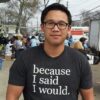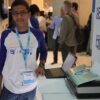Curriculum guide for Kelvin Doe who made a radio station from trash
Title: Kelvin Doe Makes Radio Station out of Trash
Background: The students will have prior knowledge about recycling and the benefits of: Reusing, Reducing, and Recycling.
The students will become familiar with the benefits of being “green” by finding ways to recycling and reuse items within the environment.
Suggested Before Strategies to Actively Engage the Students: Question and Answer Pairs, Ten-Two Strategy, and Rotating Chair Discussion.
Goals:
At the conclusion of the lesson, the students will:
~Explain reusing, reducing, and recycling.
~Cite specific reasons why it is important to recycle.
~Discuss Kelvin Doe and his effect on the citizens of Sierra Leone.
~Discuss the benefits of reducing, reusing, and recycling.
Objectives:
~Research information from books or websites book related to reusing, reducing, and recycling, together with creating a usable product from recycled material.
~Explain the living conditions in Sierra Leone.
~Discuss Kelvin Doe
~Answer quiz questions related to the Kelvin Doe article by use of memory and by referring back to the text.
~Explore the selected books related to radios, communication, and the benefits of recycling.
~Complete a quiz, aligned with the Common Core State Standards, as a form of evaluation.
Materials:
- Laptop computer or mobile device to access various websites
- Access to Smartboard or Activeboard
- Books related to recycling in addition to radios
- A physical map or medium for the students to locate Sierra Leone
- The handout of the story about Kelvin Doe
- A pen or pencil to answer the quiz questions
- Materials necessary to complete any extension activities
CCSS.ELA-Literacy.W.9-10.1.b Develop claim(s) and counterclaims fairly, supplying evidence for each while pointing out the strengths and limitations of both in a manner that anticipates the audience’s knowledge level and concerns. (i.e. provide background knowledge of words contained within the text so that the reader has a better understanding or generalization.)
Vocabulary Terms for Discussion:
Carelessly-not paying attention to what one does
Broadcast-to speak, to transmit, to cast over an area
Initiative-an act or step.
Windmill-a machine for pumping; driven by force
Engaged-busy; involved
Transmitter-a device for sending electromagnetic waves as used for broadcasting.
Resource for terms: www.dictionary.com
Geographic Term:Sierra Leone-a country located in West Africa. The climate is tropical and 70% of its people live in poverty.
Information retrieved from www.en.m.wikipedia.org (07-15-14)
CCSS.ELA-LITERACY.SL.9-10.1, 9-10.1A, 9-10.1B, 9-10.1C, and 9-10.1D
Comprehension and Collaboration
Suggested During Strategies to Actively Engage Students: 3-2-1 Format, Write-Pair-Share, and Student Summaries.
Story Line:
Most kids rather carelessly throw lots of stuff in the trash. Fifteen year-old Kelvin Doe of Sierra Leone finds stuff in the trash and built a radio station. The station broadcasts news and music and now Kelvin is known as DJ Focus. He has engaged the help of classmates (average age 12) to report the news every day in his community.
In order to give the youth of his village a voice, he thought they needed a radio station. For that, he would need a transmitter. He went to work figuring out how to make one.
Kelvin’s amazing ability to make a transmitter out of junk caught the attention of a fellow compatriot, David Sengeh, a graduate student at MIT in the United States. Sengeh was so impressed that he arranged for Kelvin to come to his famous university for three weeks. Sengeh tapped into the MIT International Developers Initiative, which paid for Kevin’s airfare to the US. Kelvin, who had never previously been further than ten miles from home, made history by becoming the youngest person ever to come to MIT on that program.
Kelvin makes what he needs and so since his community, like one and half billion other people around the globe need electricity, a windmill is to be his next invention.
Sengeh made a video of what Kelvin has created. The video also showed him coming to MIT. As result of that video, several colleges have offered Kelvin a full scholarship to come back to get a full university education. Check out that video:
http://www.takingonthegiant.com/takingonthegiant-com-quiz-video-kelvin-doe/
Reading Level: 9.2 This document contains 259 words
CCSS. ELA-LITERACY.RI.9-10.1 Cite strong and thorough textual evidence to support analysis of what the text says explicitly as well as inferences drawn from the text. (i.e. When reading the story, what information can you find that provides the reason behind Kelvin’s invitation to MIT).
Explain why Kelvin was invited to MIT.
a. David Sengeh invited Kelvin to MIT so that Kelvin could find a way to use the trash that he found in Sierra Leone and turn it into a transistor for his radio.
b. The MIT International Developers Initiative found out about DJ Focus. They wanted Kelvin to research wind power at MIT with help from David Sengeh.
c. Kelvin made a radio from trash in his home of Sierra Leone. David Sengeh, a student at MIT liked Kelvin’s work. He asked Kelvin to visit MIT and study there.
d. People who listened to DJ Focus got in touch with David Sengeh and asked for Kelvin to be invited to the MIT program.
CCSS. ELA-LITERACY.RH.9-10.5 Analyze how a text uses structure to emphasize key points or advance an explanation or analysis. (i.e. Describe what information is in the story that gives you more information to make your selection.)
Which one of these details is not important to include in the last paragraph of the text?
- Kelvin Doe is from the country of Sierra Leone. He does not have a way to use advanced radio technology. Kelvin used trash to build his own radio station. He calls himself DJ Focus.
- Kelvin is only fifteen years old. When he came to the US to visit MIT he became the youngest person invited into their International Developers Initiative.
- Before meeting Kelvin, David Sengeh did not know that anyone could make a radio transmitter from garbage. Kelvin is responsible for teaching his peers about radio technology.
Suggested After Strategies to Actively Engage Students: Jigsaw Teamwork, Think-Pair-Share, and Graphic Organizers.
Discussion Activities
Allow students to form small groups to:
- discuss possible responses to each question
- identify evidence that support their answer choices
- form a consensus to determine which answer choice is best
- present your choice to the class and be prepared to defend your choice with evidence from the text
Annotative Bibliography
Johnson, G. (2009). 1000 Ideas for Creative Reuse: Remake, Restyle, Recycle, Renew (1000 Series). Massachusetts: Quarry Books.
This book contains helpful hints about how to create items from recyclable products. Each page contains bold pictures. It is also a good resource for finding tips on how to “go green” and stay “green”.
Leisure Arts. (2009). Big Green Book of Recycled Crafts. Arkansas: Leisure Arts.
This book contains ideas for making items out of material that would ordinarily end up in a landfill. Each page contains useful ideas based upon the premise of reuse, reduce, and recycle.
Shoup, K. (2008). Rubbish! Reuse Your Refuse. Nashville: Turner Publishing.
This book contains a variety of ideas of ways to create from garbage or discarded items. The text is age appropriate and the topic is a perfect segue into the unit discussion.
Threadgould, T. (2011). ReMake It! Recycling Projects From Stuff You Usually Scrap. New York: Sterling.
Contained within this book are ideas to make projects or ways in which to utilize recycled items. The book also contains information related to items created using trash.
Walker, K. (2004). Household Waste (Recycle, Reduce, Reuse, Rethink).Minnesota: Smart Apple Media.
This book discusses the importance of recycling in order to maintain a healthy planet. This book will be helpful to the audience in which it is intended and will add to the content of the unit of study.




